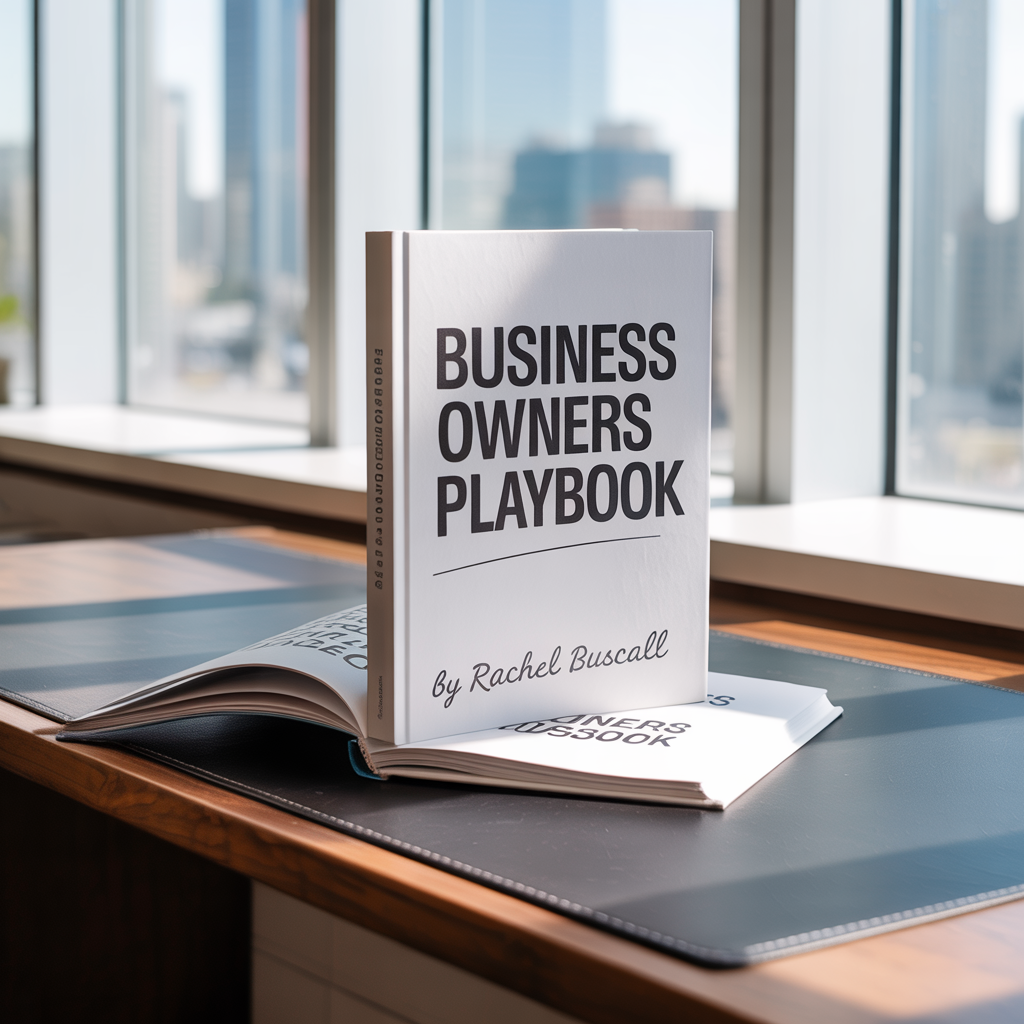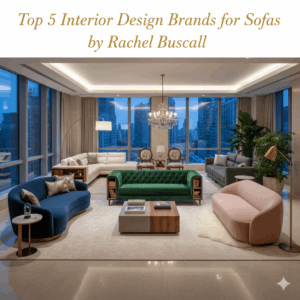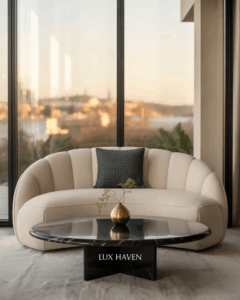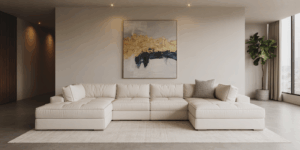Designing spaces that reflect professional success
As both a successful entrepreneur and interior designer, I’ve discovered that the spaces we inhabit profoundly influence our professional performance and personal well-being. Having built and led New Capital Link, an award-winning alternative investment firm, I understand firsthand how environment shapes business outcomes. This playbook distills my dual expertise to help business owners create spaces that not only reflect their success but actively contribute to their continued growth.
Chapter 1: The Psychology of Success-Driven Design

When I transitioned from the financial sector to interior design, I brought with me a deep understanding of how successful business minds operate. The most accomplished entrepreneurs and executives I’ve worked with share common traits: they think strategically, value quality over quantity, and understand that every decision should serve multiple purposes.
Your physical environment should mirror these same principles. A well-designed space doesn’t just look impressive—it functions as a strategic tool that enhances decision-making, boosts confidence, and communicates your professional caliber to clients and colleagues.
The Three Pillars of Business Owner Design:
- Authority – Your space should immediately communicate competence and success
- Functionality – Every element must serve your professional needs efficiently
- Inspiration – The environment should energise and motivate peak performance
Chapter 2: Designing Spaces That Reflect Professional Success
The Executive Home Office
Your home office is often the command center of your business empire. Having designed offices for CEOs, investors, and serial entrepreneurs, I’ve identified key elements that distinguish a professional workspace from a mere desk in a corner.
Essential Elements for Executive Presence:
Statement Furniture: Invest in a substantial desk that commands respect. I recommend rich woods like walnut or mahogany, or sleek materials like black granite. The desk should be large enough to spread out documents but not so massive it overwhelms the space. Pair it with a high-quality executive chair that provides both comfort during long strategy sessions and visual authority.
Professional Backdrop: Whether you’re on video calls or meeting clients in person, your backdrop tells your story. Consider a sophisticated bookshelf filled with business literature, industry awards, or meaningful artifacts from your entrepreneurial journey. Alternatively, a piece of original artwork or a view of your achievements can serve as powerful visual anchors.
Technology Integration: Modern business requires seamless technology. Plan for multiple monitors, high-quality audio-visual equipment for virtual meetings, and discrete cable management. The goal is powerful functionality without technological clutter disrupting your professional aesthetic.
Lighting Strategy: Natural light boosts mood and energy, but you’ll also need adjustable artificial lighting for different tasks. Layer ambient lighting with focused task lighting and accent lighting to create a dynamic environment that adapts to your needs throughout the day.
The Client-Facing Reception Area

First impressions in business are everything. Your reception or entry area sets expectations before any conversation begins.
Creating Immediate Impact:
Quality Over Flash: Choose fewer, higher-quality pieces rather than filling the space with multiple items. A single, exceptional piece of furniture or artwork makes a stronger statement than numerous mediocre elements.
Subtle Success Signals: Display achievements tastefully. Frame important certifications, awards, or media features, but avoid creating a “wall of ego.” The goal is confident professionalism, not boastful display.
Comfort Meets Sophistication: Provide comfortable seating that reflects your attention to client experience. Consider the physical and psychological comfort of visitors who may be nervous about important business discussions.
Chapter 3: Executive Office Design Principles
Through my work with high-level executives, I’ve identified specific design principles that consistently enhance professional performance.
The Power of Spatial Psychology
Command Position: Position your desk so you can see the entrance while having a solid wall behind you. This arrangement, rooted in ancient feng shui principles, creates subconscious feelings of security and control that translate into more confident decision-making.
Hierarchical Seating: Create different seating areas for different types of interactions. A formal meeting area with structured seating for negotiations, a casual conversation corner for brainstorming sessions, and your primary work zone where you maintain ultimate authority.
Visual Anchors: Place meaningful objects within your line of sight that remind you of your goals, values, or achievements. These might include family photos, inspirational quotes, or symbols of your business mission.
Color Psychology for Business Performance
Colors profoundly impact mood, energy levels, and cognitive performance. Based on psychological research and my experience with successful clients, here are strategic color choices:
Deep Blues: Enhance focus and rational thinking—ideal for areas where you analyse data or make strategic decisions.
Rich Grays: Provide sophisticated neutrality that allows other elements to shine while maintaining professional gravitas.
Warm Earth Tones: Create feelings of stability and groundedness—particularly effective in spaces where you meet with clients or team members.
Metallic Accents: Gold, silver, or bronze elements suggest prosperity and attention to detail without appearing ostentatious.
Material Selection for Longevity and Impact
Your material choices should reflect both current success and long-term thinking:
Natural Materials: Wood, stone, and leather age beautifully and suggest solidity and permanence—qualities investors and clients associate with reliable business partners.
Quality Textiles: Invest in high-thread-count fabrics and professional upholstery. The tactile experience of quality materials subconsciously communicates your attention to detail.
Metal Finishes: Choose finishes that complement your personal style while maintaining professional appropriateness. Brushed metals tend to photograph better for virtual meetings than high-gloss options.
Chapter 4: How Environment Impacts Business Performance
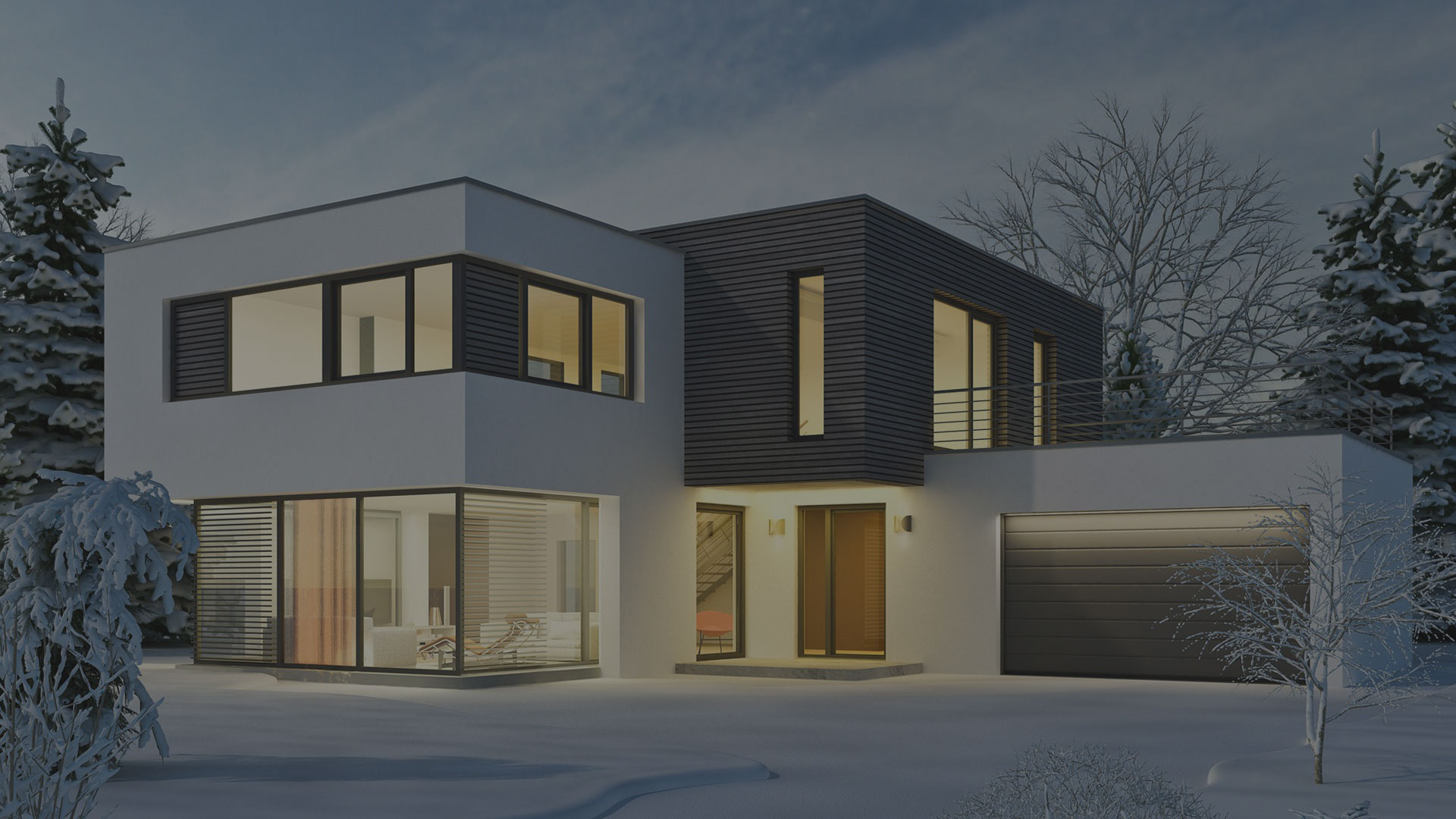
My background in finance taught me to measure everything, and environmental design is no exception. Research consistently demonstrates the connection between physical environment and business outcomes.
Cognitive Performance Enhancement
Lighting and Mental Acuity: Studies show that proper lighting can increase productivity by up to 23%. Natural light regulates circadian rhythms, improving sleep quality and next-day performance. When natural light is limited, full-spectrum LED lighting can provide similar benefits.
Color and Decision-Making: Research indicates that different colors activate different parts of the brain. Red can increase attention to detail, while green enhances creativity. Blue promotes logical thinking—crucial for financial analysis and strategic planning.
Air Quality and Performance: Poor air quality reduces cognitive function by up to 15%. Invest in high-quality air purification and consider plants that naturally improve air quality while adding visual appeal.
Stress Reduction and Peak Performance
Biophilic Design Elements: Incorporating natural elements reduces cortisol levels and improves overall well-being. This doesn’t require major renovations—even adding quality plants or natural materials can provide benefits.
Acoustic Comfort: Noise pollution significantly impacts concentration and decision-making quality. Consider sound-absorbing materials, white noise systems, or acoustic panels designed to blend seamlessly with your professional aesthetic.
Temperature Control: Optimal cognitive performance occurs at temperatures between 70-75°F (21-24°C). Individual controls allow you to adjust your environment for peak mental performance.
Client Psychology and Business Development
Your space influences not just your performance but also how clients and partners perceive your capabilities:
Trust Building: A well-organised, thoughtfully designed space suggests you’ll bring the same attention to detail to their business needs.
Value Perception: Quality environments justify premium pricing. Clients expect to pay more for services from professionals who demonstrate success through their surroundings.
Memorable Experiences: Distinctive, well-designed spaces create lasting impressions that keep you top-of-mind for future opportunities and referrals.
Chapter 5: Practical Implementation Strategies

Phase 1: Assessment and Planning
Before making any changes, conduct an honest assessment of your current space:
Functionality Audit: Track how you actually use your space over a typical week. Identify pain points, inefficiencies, and areas where the environment hinders rather than helps your performance.
Professional Image Review: Consider how your space appears to others. Take photos from various angles and review them as if you were a prospective client or business partner.
Investment Prioritisation: List potential improvements in order of impact on both daily function and professional image. Focus on changes that provide the highest return on investment.
Phase 2: Strategic Implementation
Start with Foundation Elements: Address lighting, seating, and organisation first. These fundamentals impact daily comfort and productivity more than decorative elements.
Create Focal Points: Choose one or two standout pieces that immediately communicate quality and success. These become conversation starters and memory anchors for visitors.
Plan for Growth: Design your space to accommodate business growth. Choose modular furniture and flexible layouts that can evolve with your needs.
Phase 3: Refinement and Optimisation
Regular Evaluation: Schedule quarterly reviews of your workspace effectiveness. Business needs change, and your environment should adapt accordingly.
Feedback Integration: Ask trusted colleagues and clients for honest feedback about your space. Sometimes an outside perspective reveals improvement opportunities.
Continuous Enhancement: View your workspace as an ongoing investment rather than a one-time project. Regular updates and refinements maintain freshness and demonstrate continued success.
Chapter 6: Common Mistakes and How to Avoid Them
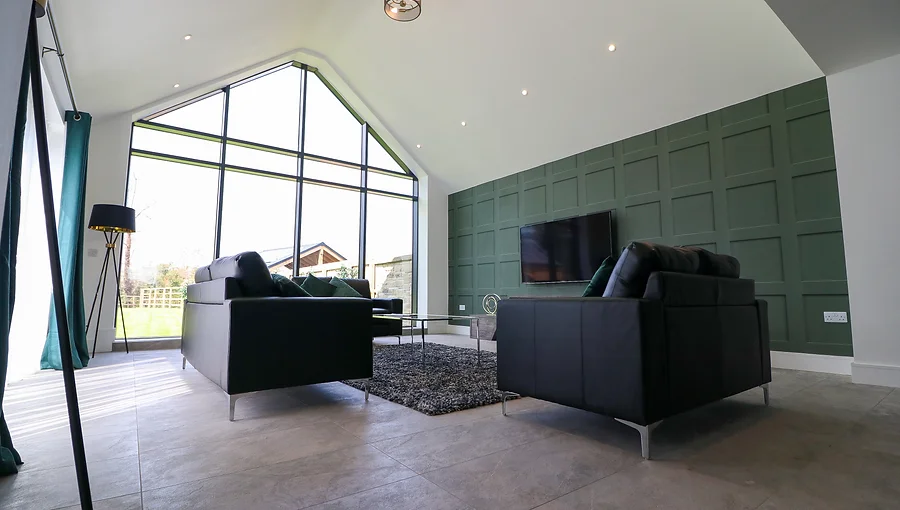
Through years of working with business owners, I’ve observed recurring mistakes that undermine professional environments:
Overcomplicating the Design
The Mistake: Trying to incorporate every trend or filling the space with too many statement pieces.
The Solution: Embrace sophisticated simplicity. Choose fewer, higher-quality elements that create cohesive impact.
Neglecting Functionality for Aesthetics
The Mistake: Prioritising appearance over practical daily needs.
The Solution: Ensure every design choice serves both form and function. Beautiful spaces that don’t work efficiently will frustrate daily operations.
Ignoring Personal Style
The Mistake: Creating a generically “professional” space that doesn’t reflect your personality or values.
The Solution: Find ways to incorporate personal elements that enhance rather than detract from professional credibility.
Underestimating the Power of Details
The Mistake: Focusing only on major furniture pieces while neglecting smaller elements.
The Solution: Pay attention to details like hardware quality, cable management, and organisational systems that demonstrate thoroughness.
Chapter 7: Measuring Success and ROI
As a business owner, you need to justify every investment, including environmental design. Here’s how to measure the return on your design investment:
Quantifiable Metrics
Productivity Tracking: Monitor task completion times and quality before and after environmental improvements.
Client Conversion Rates: Track whether improved meeting spaces correlate with higher closing rates or larger deal values.
Employee Performance: If you have team members, measure their performance and satisfaction in improved environments.
Qualitative Indicators
Personal Energy Levels: Notice changes in your daily energy, motivation, and job satisfaction.
Professional Feedback: Pay attention to comments from clients, partners, and colleagues about your space.
Business Momentum: Consider whether environmental improvements coincide with new opportunities or elevated professional relationships.
Conclusion: Your Environment as a Business Asset
Your physical environment is not an expense—it’s a strategic business asset that influences every aspect of your professional performance. From the moment you walk into your space each morning to the impression you make on your most important clients, design shapes outcomes.
As someone who has experienced the transformation from traditional business environments to thoughtfully designed spaces, I can attest to the profound impact this investment makes. The confidence that comes from working in a space that truly reflects your success and supports your goals is immeasurable.
Your space should tell the story of your journey, celebrate your achievements, and inspire your continued growth. When done thoughtfully, interior design becomes not just an aesthetic choice but a strategic advantage that sets you apart in an increasingly competitive business landscape.
Remember: every successful business owner understands the importance of investing in tools that enhance performance. Your environment is one of the most powerful tools at your disposal—use it wisely.
Rachel Buscall combines her award-winning business acumen with sophisticated design vision to create exceptional spaces for discerning clients throughout Chelmsford and beyond. Drawing from her experience as CEO of New Capital Link and her deep understanding of entrepreneurial success, Rachel transforms residential and commercial environments into spaces that inspire excellence and reflect achievement.

